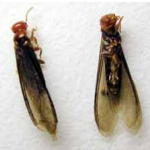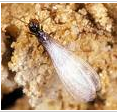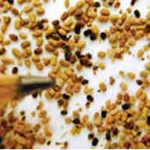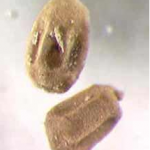The first thought that many people get when they’re told they have termites is one of a large tent going over their house and fumigation. For the most part this type of service is done not for the common subterranean termite but for the drywood variety and or wood borers that eat and live in the wood. Not so long ago this was the most effective way of eradicating these types of wood destroying pests but great strides have been made and more localized treatments can be done in a much less invasive way.
The drywood termite is different than the subterranean in several ways but it’s primarily because that it lives inside the wood it eats, subs live in the soil. The colony size is almost always smaller and centralized in a single stud, piece of furniture or area of a wall whereas the subterranean is often more spread out. Drywood termites also have very few if any soldiers in the colony as they are more protected by their surroundings and they do not, as the name suggests require as much moisture as it’s relative. Still, they are wood destroying insects and left unchecked they can get quite large in numbers and it is very common to have more than a few separate colonies in a structure all doing damage at the same time.
The drywood is a more primitive termite and much slower in colony development than other insects. It requires very little in the way of
Identifying the drywood termite is not as clean cut as some suggest. While in some species the drywood worker is larger than a subterranean of the same caste, others are almost identical so this is not a reliable key. Wings are the best way to differentiate between the two but even then a person can be fooled. Close examination of the drywood swarmer wing reveals 3 main veins at the top edge with many cross veins present that form a trapezoid shape or cell. Drywood wings also tend to be clear to smoky in appearance where the sub wings appear white when viewed together. Sub wings only have 2 main veins but to the naked eye it can be very difficult to tell if it is 2 or 3 since they are so small and the veins are very close together. Cross veins near the tips are reported in some literature but as a general rule not present and not something I’ve seen.
The damage is also an important key to separating the two termites. Subterranean termites eat with the grain of the wood and mud is almost always associated with the damage. Drwoods eat across the grain and their galleries are clean and smooth. Subterranean mud is a mixture of their saliva and fecal matter which forms a slurry and dries very hard when formed into mud tunnels. This helps keep critical moisture in the site for the sub termite and without it they would simply dry out and die. Drywoods also retain moisture but they do it by retaining it in their bodies. Their sphincters are specialized to squeeze back any moisture out of their fecal pellets and thus keeping it inside their body. The pellets then take on the shape of the muscles and will have 6 concave indention’s where the pressure was made.Of course the treatments of the two different termites is night and day as well. Subterranean termites require a soil application whereas the drywoods need above grade service. In some cases you can simply remove the infested wood and either treat or discard it and that will rid you of the drywood termite. Wood injections can be very effective but the trick is hitting the right spot.
Although the two termites are related they don’t seem to have very many of the same attributes at all. It can be difficult without training to tell the difference but having that knowledge could save you from making a costly mistake. Don’t rely on one piece of evidence unless you have a pro to help you. You might just end up treating for subterranean termites when it’s drywoods that are flitting about and no one will be happy then, except perhaps the drywood termite.








